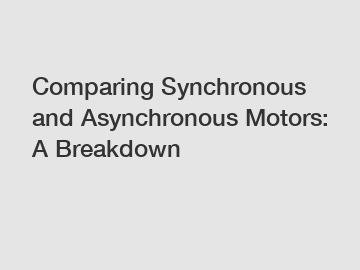Comparing Synchronous and Asynchronous Motors: A Breakdown
Mar. 27, 2024
In the world of electric motors, there are two main types that are commonly used in various industrial and commercial applications: synchronous motors and asynchronous motors. Both types have their own unique characteristics and advantages, making them suitable for different types of tasks. Understanding the differences between synchronous and asynchronous motors can help you choose the right one for your specific needs.
Synchronous motors are motors in which the rotor turns at the same speed as the rotating magnetic field in the stator. This means that the rotor and stator magnetic fields are always in sync, hence the name "synchronous." These motors are known for their constant speed operation and high efficiency. They are commonly used in applications where precise speed control is required, such as in industrial automation systems, robotics, and synchronous generators.
On the other hand, asynchronous motors, also known as induction motors, operate at speeds slightly lower than the synchronous speed of the rotating magnetic field in the stator. This difference in speed creates a slip between the rotor and the stator, which allows asynchronous motors to start and run without the need for external control of the rotor speed. Asynchronous motors are widely used in applications where variable speed operation is required, such as in HVAC systems, pumps, fans, and conveyors.

One of the key differences between synchronous and asynchronous motors is their speed control capabilities. Synchronous motors are inherently constant speed motors, meaning that their speed is directly proportional to the frequency of the AC power supply. This makes them ideal for applications that require precise speed control, such as in CNC machines and high-precision equipment. In contrast, asynchronous motors can operate at variable speeds by adjusting the frequency of the power supply or using external speed control devices. This flexibility makes asynchronous motors well-suited for applications that require varying speeds, such as in variable-speed drives and conveyor systems.
Another important factor to consider when comparing synchronous and asynchronous motors is their efficiency. Synchronous motors are known for their high efficiency, especially at full load and synchronous speed. This makes them ideal for applications where energy efficiency is a priority, such as in electric vehicles and renewable energy systems. Asynchronous motors, on the other hand, have slightly lower efficiency compared to synchronous motors, especially at low speeds and partial loads. However, advancements in motor technology, such as the use of variable frequency drives, have improved the efficiency of asynchronous motors, making them a viable option for energy-efficient applications.
When it comes to maintenance and reliability, synchronous motors have an advantage over asynchronous motors. Synchronous motors are simpler in design and have fewer moving parts, which reduces the likelihood of mechanical failures. Additionally, synchronous motors do not suffer from the same type of rotor losses as asynchronous motors, making them more reliable in the long run. On the other hand, asynchronous motors require more maintenance due to the presence of brushes and slip rings, which can wear out over time and require replacement. Despite this, asynchronous motors are still widely used in many industrial applications due to their versatility and cost-effectiveness.
In conclusion, both synchronous and asynchronous motors have their own strengths and weaknesses, making them suitable for different types of applications. Synchronous motors are well-suited for applications that require precise speed control and high efficiency, while asynchronous motors are ideal for applications that require variable speed operation and cost-effectiveness. By understanding the differences between these two types of motors, you can choose the right one for your specific needs and ensure optimal performance in your application.
For more information, please visit Asynchronous Induction Motor Price, Slip of Induction Motor at Starting, Which Is the Main Application of Synchronous Motor?.
92
0
0
Next: None


Comments
All Comments (0)